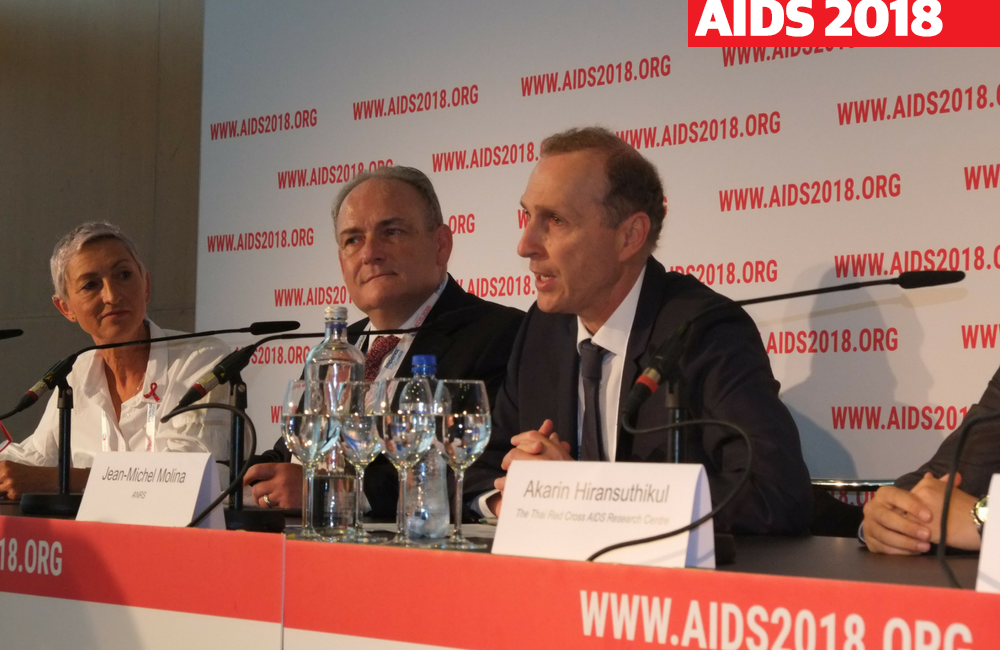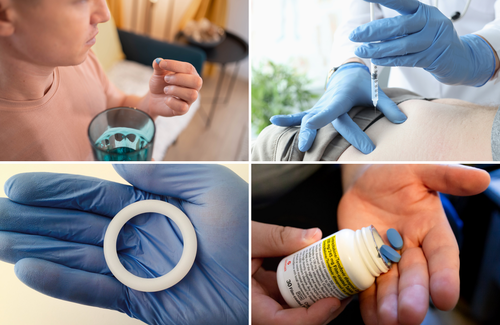
There have been no new HIV infections in the 1628 people taking part in a demonstration study of pre-exposure prophylaxis (PrEP) in France. Over half of participants chose to use on-demand dosing for PrEP, with the rest opting for daily dosing, but both have been equally effective, Jean-Michel Molina of the University of Paris Diderot told a press conference at the 22nd International AIDS Conference (AIDS 2018) in Amsterdam today.
The ‘Prévenir’ (prevent) study is gathering data on the best ways to deliver PrEP in Île-de-France, which is the region of Paris and its suburbs. The researchers hope to show that having an extra 3000 people take PrEP will result in a marked fall in HIV diagnoses among men who have sex with men in the region.
Molina presented data on the first year (from May 2017) of the three-year study. A total of 1628 people have enrolled, almost all of whom (98.8%) are men who have sex with men. Twelve heterosexual men and women as well as eight transgender people have enrolled.
Most participants are in their thirties or early forties; just over half do not have any regular sex partners; and 57% had previously used PrEP before enrolling in Prévenir.
Participants can choose whether to follow the on-demand dosing schedule (sometimes referred to as ‘event-driven’ or ‘event-based’ dosing) that was validated in the IPERGAY study, or to use daily dosing, which is more commonly used in other parts of the world. On-demand dosing involves taking a double dose of PrEP (two pills) from 2-24 hours before anticipated sex, and then, if sex happens, additional pills 24 hours and 48 hours after the double dose. In the event of sex on several days in a row, one pill should be taken each day until 48 hours after the last sexual intercourse.
At enrolment, on-demand dosing was chosen by 54.6% and daily by 45.4%. The number choosing on-demand is much higher than in the Belgian and Dutch studies, reported below.
There were some differences in the profiles of those choosing the two options. Those choosing daily dosing tended to have had more sexual partners (15 in the past three months) and more condomless sex (three times in the past four weeks) than those choosing on-demand dosing (ten and two, respectively).
Although the trial has been open for a year, the average (mean) period of follow-up is seven months. Molina presented data on 506 and 443 person-years of follow-up in the on-demand and daily groups, respectively.
There have been zero infections in both groups. Annual incidence in the on-demand group is therefore 0 (95% confidence interval 0-0.7) and in the daily group 0 (95% confidence interval 0-0.8). The researchers estimate that, so far, 85 HIV infections have been avoided in this cohort of 1628 people.
Based on self report, 96.2% of sexual acts reported by people taking on-demand PrEP have been ‘covered’ by PrEP – meaning that the person took the recommended doses before and after sex. The equivalent figure for those taking daily PrEP is 95.8%.
Condoms have been used during 22% and 19% of sexual acts, in those using on-demand and daily PrEP, respectively.
There are indications of changes in sexual behaviour. Over the first year of the study, while average partner numbers have declined, condomless sex has increased – in on-demand PrEP users, from a median of two to four times in the past four weeks; in daily PrEP users, from three to six times. However, as less than one in ten people have been in the study long enough to provide data over the full year, these results should be interpreted with caution.
There have been eleven infections of hepatitis A, C or E (an incidence of just over 1% in both arms). Side-effects and abnormal kidney results have been limited, with no differences between arms. Study retention has been good (a drop-out rate of 3.3% per year).
Molina believes these data strengthen the case for the safety and effectiveness of on-demand PrEP (currently supported by guidelines of the European AIDS Clinical Society as well as the national bodies in France, the UK, Canada and Australia). It is an option that has the potential to boost the uptake of PrEP, he told the press conference.
On-demand dosing in Belgium and the Netherlands
Belgium also has a demonstration study offering either on-demand or daily PrEP, known as Be-PrEP-ared. The researchers have recruited 197 gay men and three transgender women. In contrast to France, over three-quarters selected daily dosing, whereas a quarter chose on-demand. Although the numbers are small, adherence appears to be poorer in the on-demand group (around 70% of sexual acts covered by PrEP).
Despite high levels of self-reported risk behaviour and a high incidence of sexually transmitted infections, there have been no HIV infections in the first 12 months of follow-up. These are interim results and the study continues.
The set-up of the Amsterdam PrEP Project (AmPrEP) is similar. Between August 2015 and March 2018, 370 gay men and two transgender people have enrolled, with 73% choosing daily PrEP and 27% on-demand. As previously reported, there has been a highly unusual case of a man taking daily PrEP acquiring HIV.
With the Dutch study’s longer period of follow-up, the researchers are able to give more meaningful data on people switching between dosing regimens. In the first two years of taking PrEP, 49% of those who began with on-demand dosing and 20% of those who began with daily dosing have switched at least once (some people have switched back and forth). Younger people were more likely to switch; people having a lot of sex were more likely to switch away from on-demand dosing.
The researchers say that the high number of switches show how PrEP users’ needs vary and suggest the value of a client-centered approach in providing PrEP.
Molina JM et al. Incidence of HIV-infection in the ANRS Prevenir Study in the Paris Region with daily or on demand PrEP with TDF/FTC. 22nd International AIDS Conference (AIDS 2018), Amsterdam, abstract WEAE0406LB, 2018.
View the abstract on the conference website.
Vuylsteke B et al. Daily or event-driven PrEP? Interim results of “Be-PrEP-ared”, a PrEP demonstration project among men who have sex with men in Belgium. 22nd International AIDS Conference (AIDS 2018), Amsterdam, abstract THPEC320, 2018.
View the abstract on the conference website.
Download the e-poster from the conference website.
Hoornenborg E et al. Different PrEP modalities for different people: switches between daily and event-driven PrEP among MSM and TGP. 22nd International AIDS Conference (AIDS 2018), Amsterdam, abstract LBPEC034, 2018.

